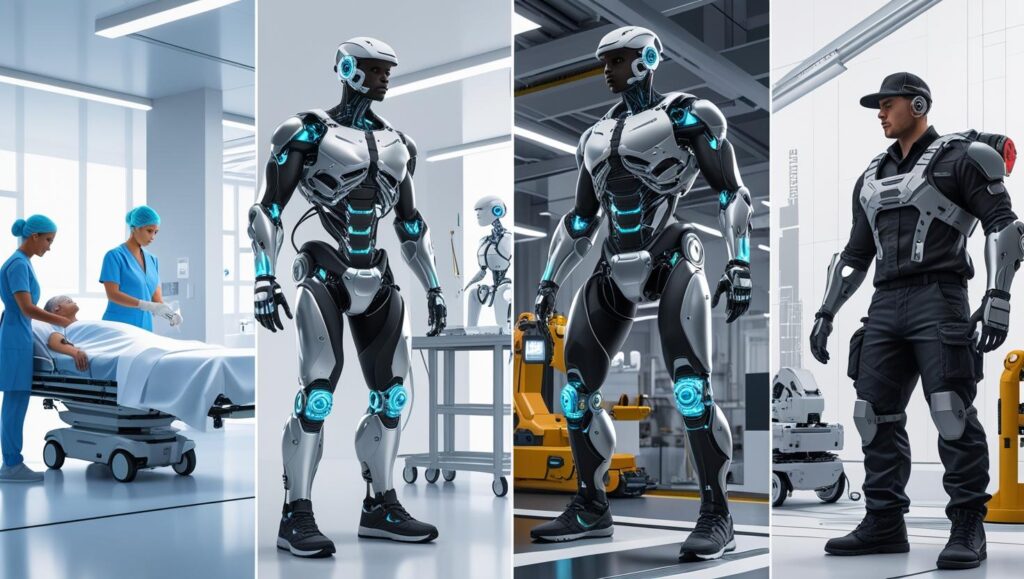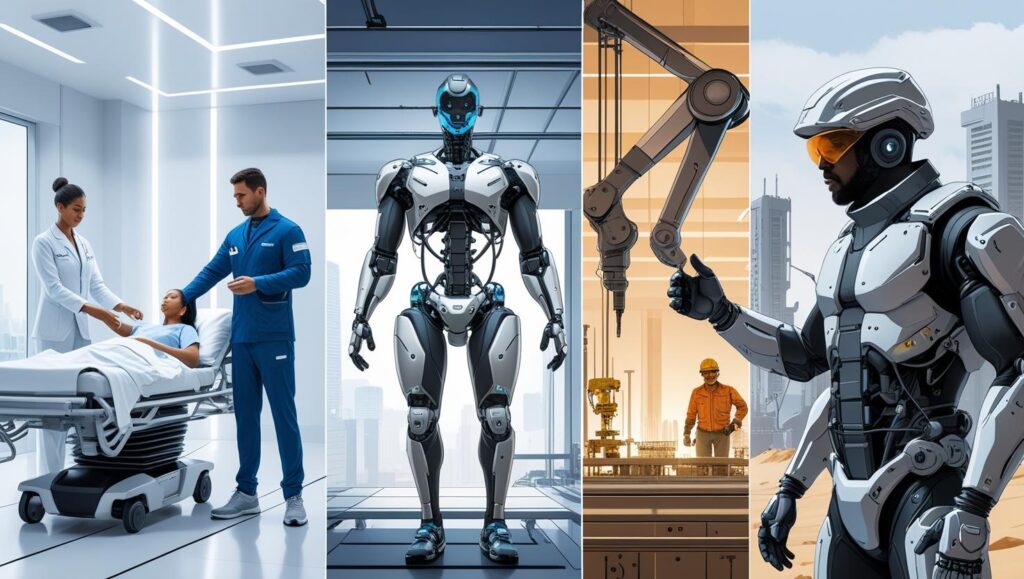The exoskeleton market has undergone a significant transformation over the past decade, evolving from an experimental technology primarily used in medical rehabilitation to a mainstream solution addressing challenges across multiple industries. As advancements in robotics, artificial intelligence (AI), and materials science accelerate, exoskeletons are moving beyond healthcare to reshape how industries approach worker safety, productivity, and human augmentation. Today, the exoskeleton market is positioned at the intersection of assistive technology and industrial efficiency, creating opportunities for innovation, collaboration, and growth.

Evolution of Exoskeleton Technology
Exoskeletons are wearable devices designed to support, enhance, or augment the physical capabilities of the human body. Initially developed to aid individuals with mobility impairments or neurological conditions, early exoskeleton designs were primarily focused on assisting patients in rehabilitation settings. Medical exoskeletons enabled paraplegics to walk, stroke patients to regain balance, and individuals recovering from injury to strengthen their muscles.
However, with growing R&D investments and interest from industries outside healthcare, exoskeleton technology quickly began adapting to meet the physical demands of the workforce, especially in sectors like manufacturing, construction, logistics, and defense. Lightweight designs, powered suits, and passive mechanical support systems have all emerged to cater to various commercial and industrial needs.
Healthcare and Assistive Applications
The healthcare sector remains a key contributor to the growth of the exoskeleton market. Exoskeletons used in physical therapy clinics and hospitals have proven highly effective in helping patients regain motor functions. Devices designed for spinal cord injuries, stroke rehabilitation, and muscular dystrophy provide structured movement therapy that accelerates recovery.
With aging populations in many developed countries, the demand for assistive technologies that improve the quality of life for elderly individuals has also surged. Wearable exoskeletons can help seniors with limited mobility maintain independence, reduce fall risks, and participate more actively in daily activities. This demographic trend ensures sustained investment in healthcare-focused exoskeletons for years to come.
Rise of Industrial Exoskeletons for Worker Efficiency
As global industries face increasing pressure to improve operational efficiency while addressing ergonomic risks, exoskeletons have emerged as a practical solution. In physically demanding industries like automotive manufacturing, aerospace, construction, and warehousing, workers are routinely exposed to repetitive lifting, awkward postures, and strenuous tasks that contribute to fatigue and musculoskeletal injuries.
Industrial exoskeletons help mitigate these risks by redistributing weight, supporting the spine, and providing mechanical assistance to reduce strain on muscles and joints. By decreasing physical fatigue, companies can improve worker productivity, reduce injury rates, and minimize downtime due to medical leave. Automotive manufacturers, including major global brands, have been among the first to deploy exoskeletons on assembly lines, with encouraging results in worker safety and output.
The global exoskeleton industry is projected to grow from USD 0.56 billion in 2025 to USD 2.03 billion by 2030, at a CAGR of 29.4% during the forecast period.
Download PDF Brochure @ https://www.marketsandmarkets.com/pdfdownloadNew.asp?id=40697797

Military and Defense Adoption
The defense sector has shown growing interest in exoskeleton technology, particularly for enhancing soldier endurance, strength, and load-carrying capacity. Military exoskeletons enable soldiers to carry heavier equipment over long distances, navigate difficult terrain, and reduce fatigue during extended operations.
Several defense agencies around the world, including in the United States, Europe, and Asia, are actively funding projects to develop rugged, combat-ready exoskeleton systems. These initiatives focus not only on improving individual soldier performance but also on enhancing the overall effectiveness of military units in challenging environments.
Integration of AI and Robotics
The convergence of artificial intelligence and exoskeleton design is accelerating innovation across the market. AI algorithms can help exoskeletons adapt to the user’s specific movements, providing tailored support based on real-time feedback. Machine learning models optimize gait patterns in rehabilitation applications, while predictive analytics help prevent overexertion in industrial settings.
Additionally, robotic advancements have allowed for smoother joint articulation, reduced bulk, and increased responsiveness in powered exoskeletons. This fusion of AI and robotics is critical in transforming exoskeletons from purely assistive devices to intelligent, performance-enhancing tools for both individuals and industries.
Key Market Trends Driving Growth
One of the standout trends in the exoskeleton market is the emphasis on lightweight, ergonomic designs. Early iterations of industrial exoskeletons were often bulky or cumbersome, limiting their adoption in busy work environments. Today’s devices prioritize comfort and mobility, enabling longer wear times and practical deployment on job sites.
Customization and modularity are also shaping the market, with manufacturers offering adjustable designs tailored to specific applications, body types, and industries. Whether assisting with overhead tasks, heavy lifting, or repetitive squatting, modern exoskeletons are adaptable to meet diverse operational needs.
The development of passive exoskeletons, which operate without motors or external power sources, has gained popularity in industrial settings. These devices provide mechanical support through tension springs or other mechanisms, offering simplicity and reliability while remaining cost-effective.
Furthermore, partnerships between technology providers and industry leaders have accelerated commercialization. Collaborations between exoskeleton developers and automotive manufacturers, healthcare providers, and defense contractors have created testing grounds for refinement and scalability.
Growth opportunities
The exoskeleton market is witnessing a surge in growth opportunities, particularly in healthcare and industrial sectors. As global populations age and the demand for advanced rehabilitation rises, exoskeletons are becoming essential tools in medical facilities for assisting patients with mobility impairments, spinal injuries, and post-stroke rehabilitation. These wearable robotic systems provide enhanced physical support, accelerating recovery timelines and improving quality of life for patients and the elderly. Additionally, with increasing investments in defense sectors worldwide, military-grade exoskeletons are being developed to augment soldier strength, endurance, and operational efficiency in challenging environments.
Beyond healthcare, the industrial sector presents a lucrative opportunity for exoskeleton adoption. Manufacturing, logistics, construction, and aerospace industries are actively exploring wearable robotics to reduce workplace injuries and improve worker productivity. Exoskeletons designed for industrial applications help workers lift heavy objects, maintain ergonomic posture, and work longer with reduced fatigue. As technology evolves, integrating AI and IoT capabilities into these suits will enable smart, adaptive systems that respond to real-time movements and tasks. Emerging economies, especially in Asia-Pacific, are expected to play a key role in driving future growth through increased adoption in both healthcare and industrial sectors.
Challenges and Barriers to Adoption
Despite promising advancements, the exoskeleton market faces several challenges. High initial costs remain a barrier, especially for smaller organizations looking to deploy wearable robotics at scale. While ROI can be demonstrated through long-term productivity gains and reduced injury-related costs, upfront expenditures may deter some buyers.
Regulatory frameworks for exoskeletons are still evolving, particularly for industrial applications. Ensuring that wearable devices comply with workplace safety standards and ergonomic guidelines is an ongoing process in many regions.
Additionally, user acceptance and training present challenges in adoption. Workers unfamiliar with wearable robotics may initially resist the technology, necessitating comprehensive education, hands-on training, and continuous feedback mechanisms to build trust and proficiency.
Future Outlook for the Exoskeleton Market
Looking ahead, the exoskeleton market is poised for steady growth, driven by both demand-side needs and technological innovation. Market research forecasts suggest continued double-digit growth rates globally, with Asia-Pacific emerging as a significant contributor due to its expanding manufacturing sector and aging population demographics.
Technological breakthroughs in battery life, lightweight materials such as carbon composites, and AI-driven control systems will further enhance the viability and appeal of exoskeleton solutions. As production costs decline through scale, more industries will find exoskeletons to be not just a tool for specialized tasks but an integral part of standard operating procedures.
Moreover, the push for workplace automation, Industry 4.0 integration, and Industry 5.0 initiatives emphasizing collaboration between humans and machines will position exoskeletons at the forefront of future labor strategies. They will increasingly be viewed as extensions of human ability rather than merely assistive aids.
The evolution of the exoskeleton market from purely assistive technology to a catalyst for industrial efficiency represents a major milestone in wearable robotics. While initially designed to restore mobility and aid rehabilitation, exoskeletons have matured into versatile, valuable tools across healthcare, manufacturing, defense, and beyond.
As industries worldwide grapple with labor shortages, rising healthcare costs, and the demand for higher productivity, exoskeletons offer a compelling solution. By enhancing human capabilities, reducing injuries, and supporting workforce longevity, these wearable technologies will play an increasingly vital role in shaping the future of work and healthcare.
The journey of exoskeletons is only beginning, with the potential to transform both individual lives and entire industries.
Frequently Asked Questions (FAQ) About the Exoskeleton Market
What industries use exoskeletons?
Exoskeletons are used in healthcare (rehabilitation, mobility assistance), manufacturing (reducing worker fatigue), construction (lifting support), logistics (material handling), and defense (enhancing soldier performance).
How do exoskeletons benefit the healthcare industry?
In healthcare, exoskeletons aid in physical therapy, helping patients with spinal cord injuries, strokes, or neurological disorders regain mobility and muscle strength through structured movement assistance.
Why are industrial exoskeletons gaining popularity?
Industrial exoskeletons help reduce workplace injuries, improve worker productivity, and prevent long-term musculoskeletal disorders by supporting the body during repetitive or strenuous tasks.
What’s the difference between passive and powered exoskeletons?
Passive exoskeletons use springs or mechanical components to provide support without external power. Powered exoskeletons use electric motors and sensors to actively assist movement and require batteries or power sources.
Are exoskeletons safe to use in industrial environments?
Yes. Many industrial exoskeletons are specifically designed with safety in mind, often undergoing rigorous testing and meeting ergonomic and workplace safety standards.
How is artificial intelligence (AI) being integrated into exoskeletons?
AI is used to analyze user movements in real-time, allowing powered exoskeletons to provide tailored support, optimize gait, or predict strain, thereby enhancing comfort and efficiency.